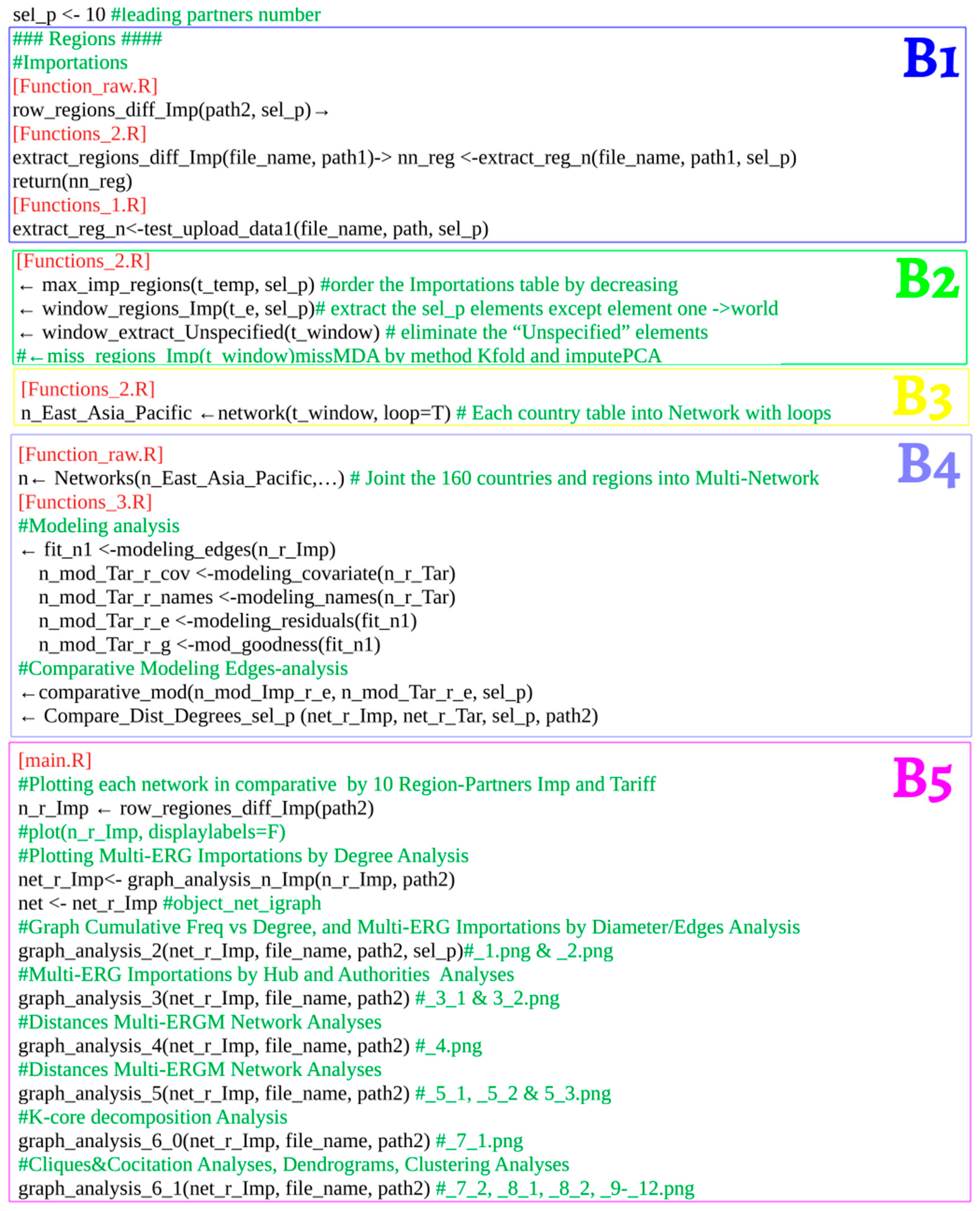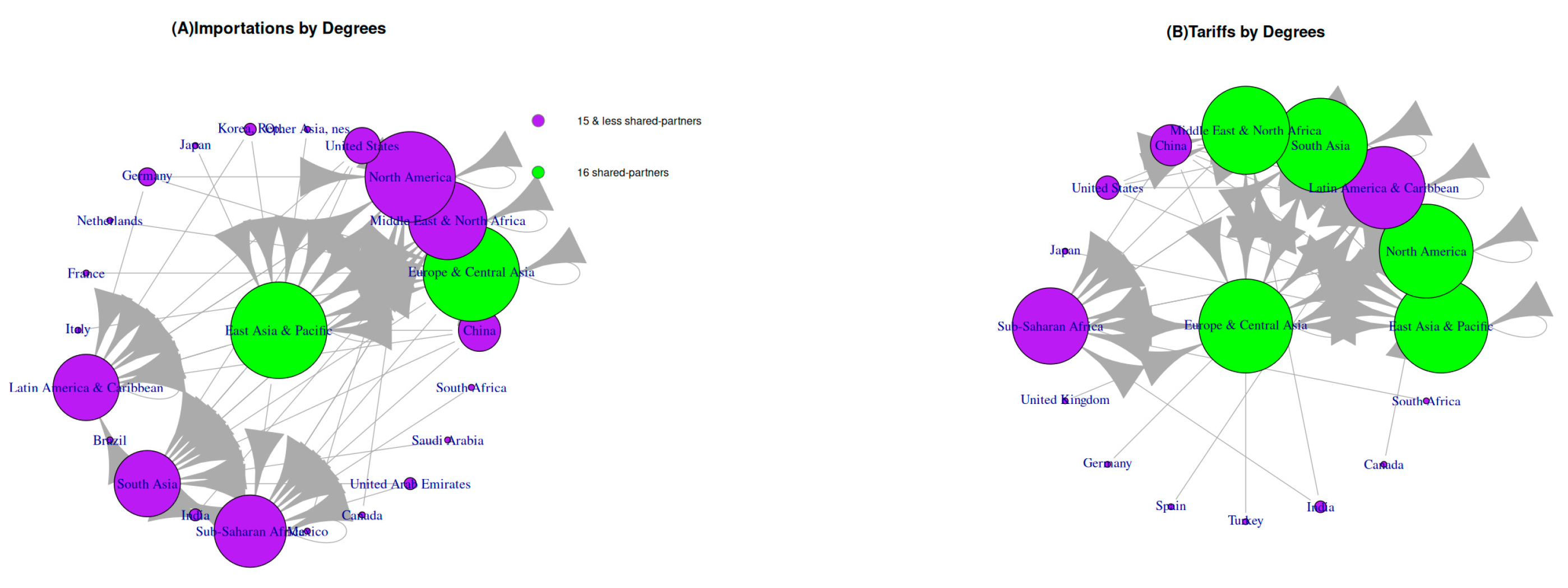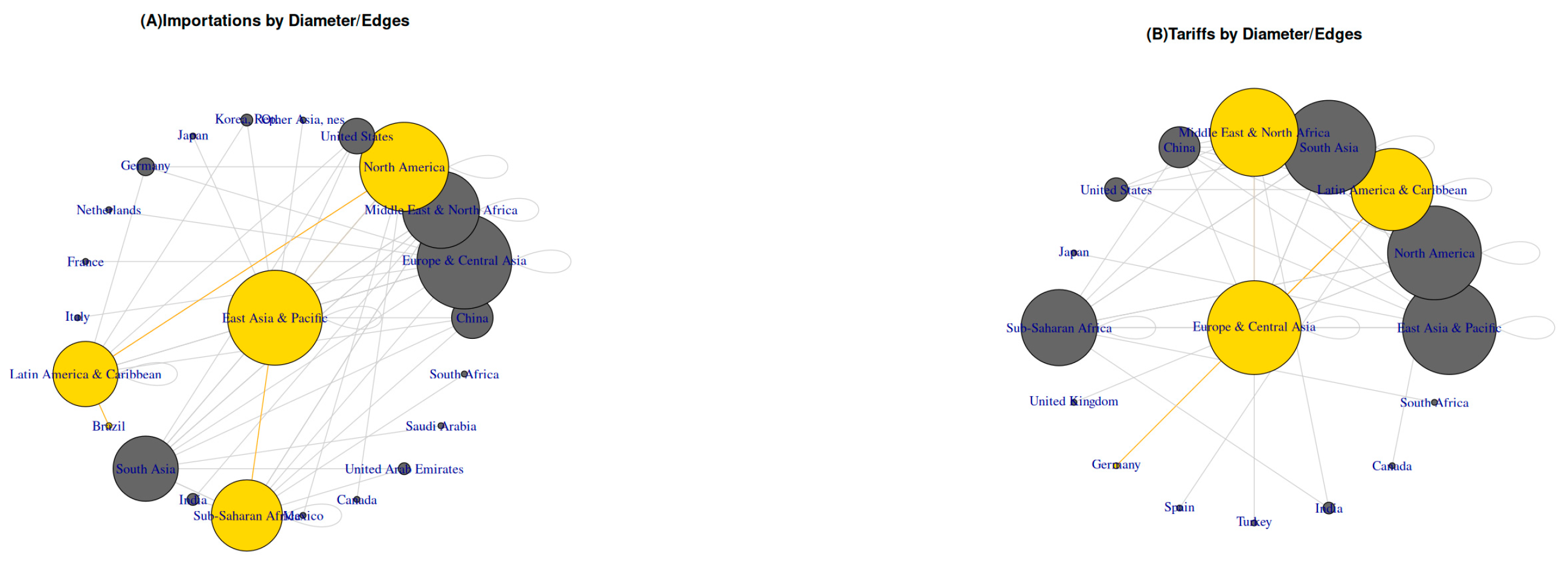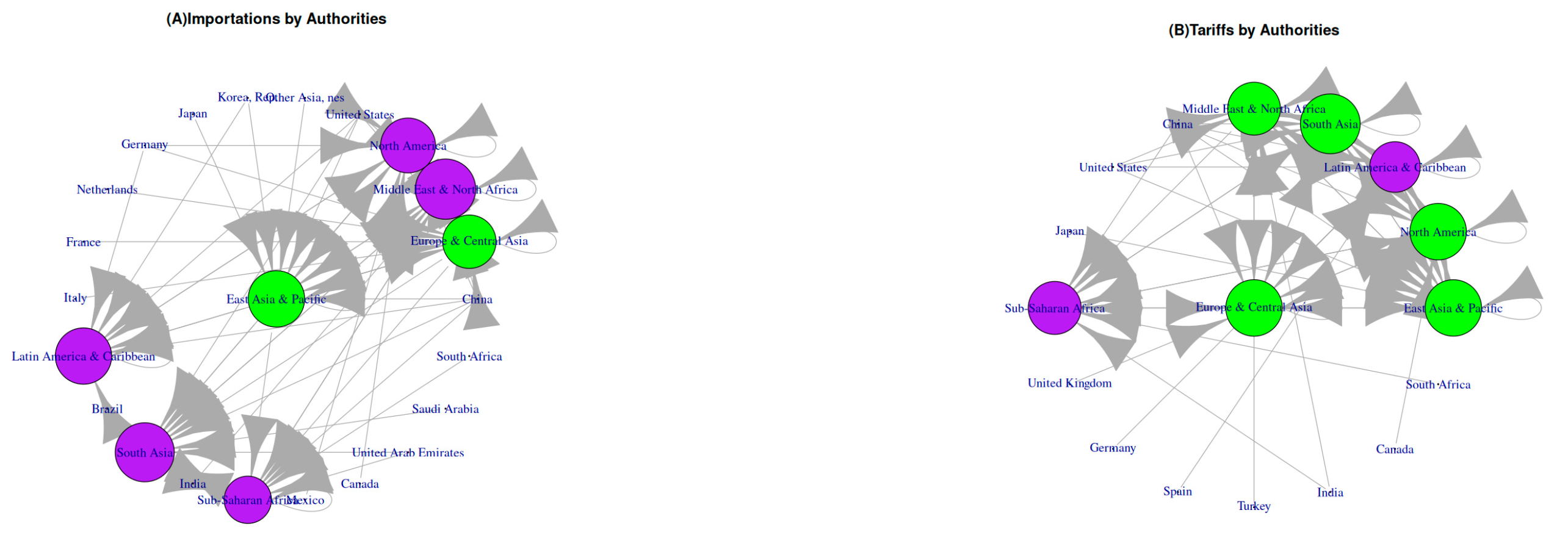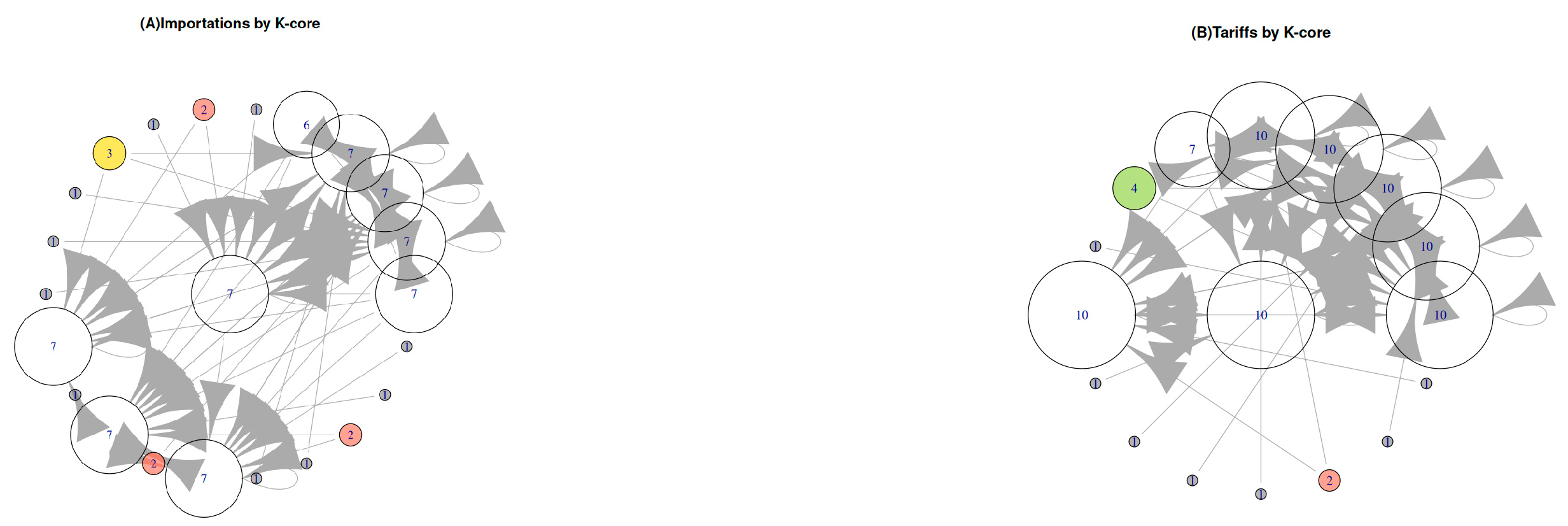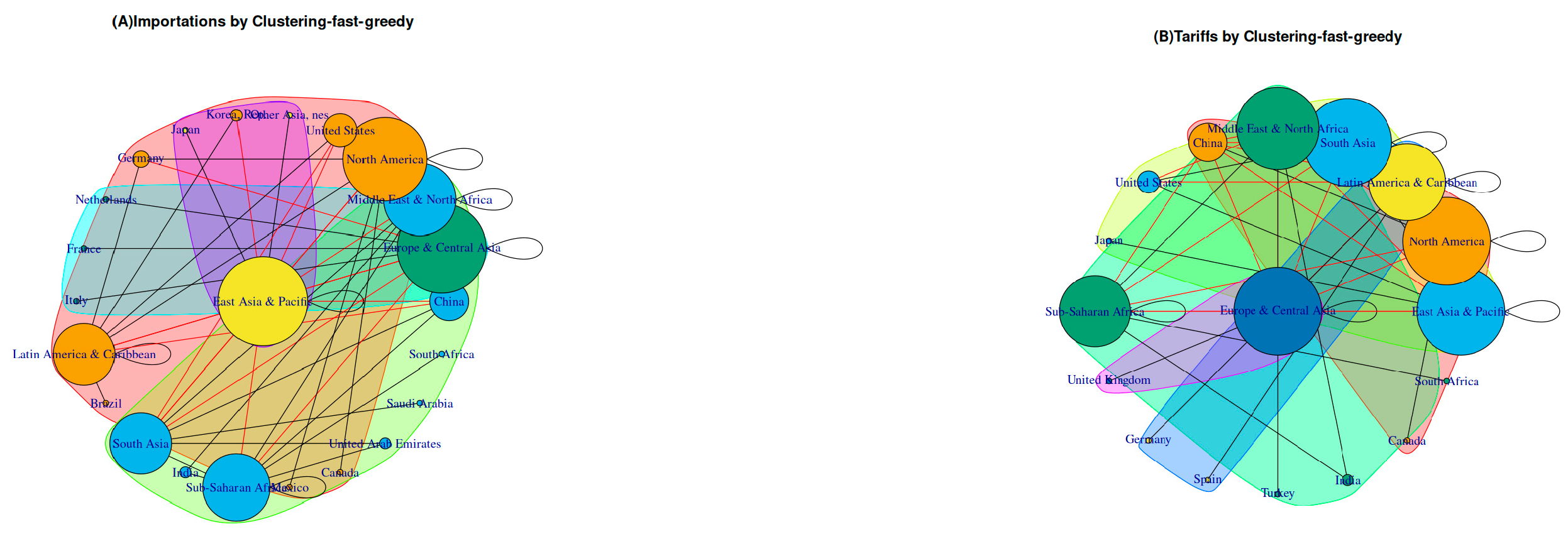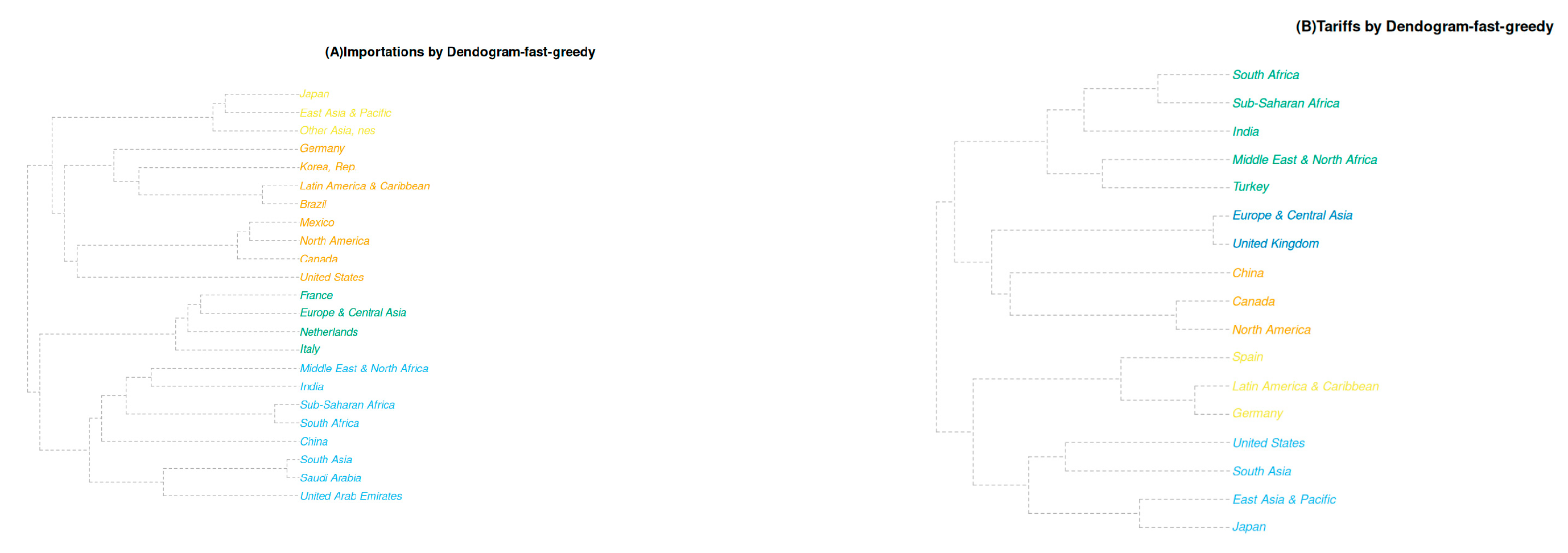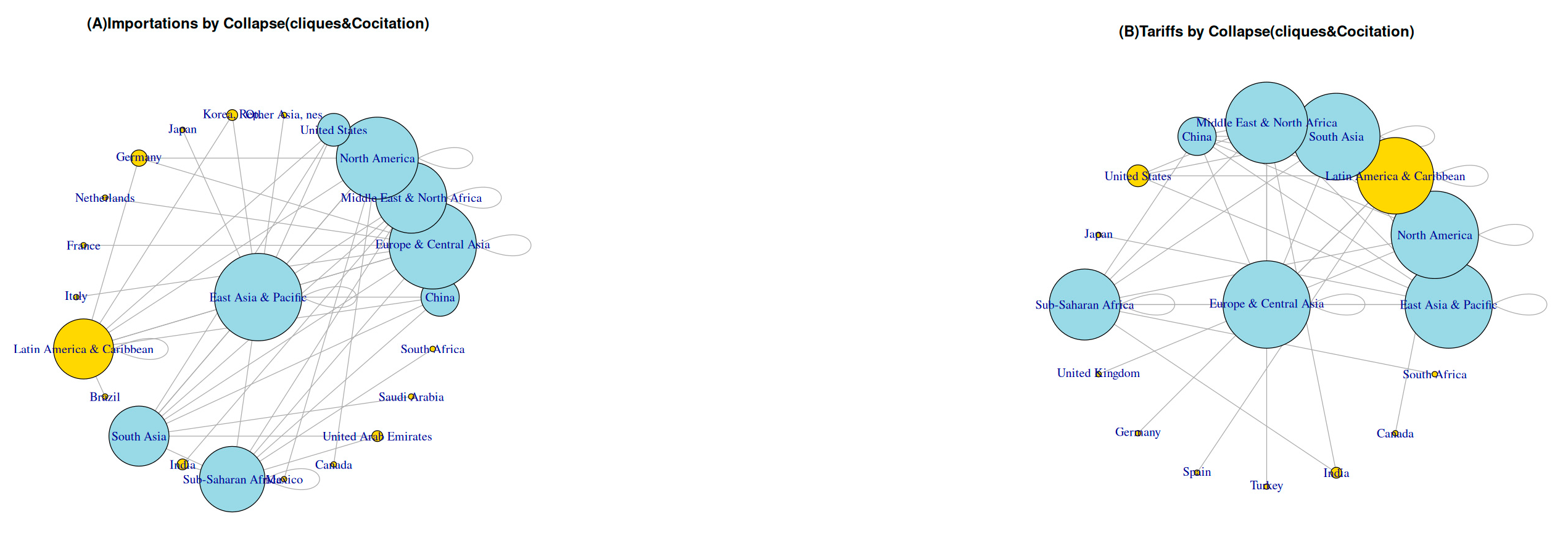5.1. Fundamental Parameter Multi-ERGM Network Analyses
Multi-ERGM RPI Network Analysis: To understand the complex relationship between the actors of this multilayer small network, which corresponds to Multi-ERGM RPI, it is essential to know the total edge density, which is 0.1245059. For more details on how to calculate this parameter, refer to [
70]. The reciprocity [
45] is calculated with dyad values and the mutuality between the edges, which is 0.2807018. The global transitivity is 0.5030488 and those in specific vertices are as follows: the East Asia and Pacific region with 0.4181818, Europe and Central Asia with 0.3636364, North America with 0.4444444, the Middle East and North Africa with 0.6785714, the LA&CR with 0.4285714, South Asia with 0.5277778, China with 0.8095238, the United States with 0.8666667, and the Republic of Korea, the United Arab Emirates, and India with 1.0000000. The maximum transitivity of Multi-ERGM RPI is 1.0000000 for two elements, and the lowest value is observed in the Europe and Central Asia region.
The betweenness parameters in Multi-ERGM RPI are in the Europe and Central Asia region with 22.0, the East Asia and Pacific region with 39.0, the LA&CR with 6.5, the Middle East and North Africa with 26.0, North America with 23.5, Sub-Saharan Africa with 9.0, South Asia with 10.0, and China, the United States, Japan, Germany, the Netherlands, France, Italy, Brazil, India, Mexico, Canada, the United Arab Emirates, Saudi Arabia, and South Africa with 0.000000. The maximum betweenness is in the East Asia and Pacific region, and the minimum is 10 elements with a value of 0.000000.
Multi-ERGM RPT Network Analysis: A detailed description of the complex Multi-ERGM RPT network requires a meticulous examination to know the total edge density, which is 0.2316176. The reciprocity is calculated with dyad values and the mutuality between the edges, which is 0.6071429. The global transitivity is 0.6375, and those in specific vertices are as follows: East Asia and Pacific, 0.6111111; Europe and Central Asia, 0.6785714; North America, 0.6785714; the Middle East and North Africa, 0.5000000; the LA&CR, 0.4285714; South Asia, 0.7857143; China, 0.9047619; the United States, 0.8333333; Sub-Saharan Africa, 0.5714286; and India, 1.0000000. The maximum transitivity of Multi-ERGM RPT applies to China, and the lowest is that of the LA&CR.
The betweenness parameters in Multi-ERGM RPT are Europe and Central Asia with 10.285714, East Asia and Pacific with 8.976190, North America with 10.285714, the LA&CR with 12.500000, South Asia with 5.119048, the Middle East and North Africa with 9.904762, Sub-Saharan Africa with 7.928571, and China, the United States, Japan, the United Kingdom, Germany, Spain, Turkey, India, Canada, and South Africa with 0.000000. The maximum betweenness is in the LA&CR (LA&CR), and the lowest and the minimum values are 10 elements with a value of 0.000000.
Multi-ERGM RPI vs. Multi-ERGM RPT Analysis: For this comparison, it is fundamental to compare the graph network parameters, like edge density which is 0.1245059 for Multi-ERGM RPI and 0.2316176 for Multi-ERGM RPT with 0.107117 of difference. The reciprocity is 0.2807018 for the first complex network (Multi-ERGM RPI) and 0.6071429 for the second complex network (Multi-ERGM RPT) with 0.3264411 of variation. The global transitivity is 0.5030488 for the first one and 0.6375 for the second one with 0.1344512 of difference. The maximum transitivity of Multi-ERGM RPI is seen for the United Arab Emirates and India and the lowest for the Europe and Central Asian region; alternatively, the maximum transitivity of Multi-ERGM RPT is seen for China and the lowest for the LA&CR. The maximum closeness value (see Note 3) for the first complex network is seen for the Europe and Central Asia region and the lowest for Brazil; in contrast, the maximum closeness value for the second complex network is seen for the East Asia and Pacific region and the lowest value is for Germany. The maximum betweenness for Multi-ERGM RPI is seen for the East Asia and Pacific region, while the maximum betweenness for Multi-ERGM RPT is seen the LA&CR.
Note 3: In the context of ERGMs multilayer analysis, the weight parameters, such as closeness (centrality based on distance to others in the graph), were configured as follows (see Supplementary File S1.1 and block B5 in pink): closeness(net, mode = “all”, weights = NA). Partial Conclusions: One of two methods of how to calculate the edge density is as follows (see
Supplementary File S1 and methodology block B5 in pink): ecount (net)/(vcount (net) ×vcount (net) −1). That means, the total number of region-partners (see
Supplementary File S4. Network list) is involved in the tariff network. The prevalence of ties (cumulative frequency, see
Figures S13 and S14 in Supplementary File S4) has 20.8% of the total connectivity over all possible connections in the network, which is higher than the partners from the importation network (12.4%); their connectivity is stronger by 10.7%. The reciprocity parameter helps us to understand the relationship between ties and whether they are reciprocal or mutual. In both multilayer networks, the probability is positive (although it could be negative); the network of tariffs accounts for around a 60% chance of finding a shared partner in reciprocal occurrence compared to the importation partners network. Transitivity is a measure of the presence of triads or triangles (three shared partner groups). Global transitivity indicates that if you randomly select a group of three shared partners in the tariff network, there is a 50.3% chance that they are connected, and in the importation network, a 63.75% chance. Additionally, the maximum transitivity can help us to identify the presence of a specific partner country in the connections of triads.
Possible Diagnosis: One possible reason why the United Arab Emirates and India exhibit the highest transitivity (1.0) in the network of imports (Multi-ERGM RPI) is that these actors have distinct consumer preferences. In an economic context, the transitive preference means they prefer good A over good B. But, in the network analysis, a highly transitive network means the actor A is connected with B, and B with C, and thus A and C are also likely to be connected (due to logistic hubs, strategic geographic location, etc.); a high transitivity also occurs when a country imports goods not for its own use, but to re-export them to other markets, leveraging its position in global market networks. Taking this into account, the United Arab Emirates and India have strong connectivity within the global trade network. In contrast, the Europe and Central Asian region has the lowest transitivity within the global treatment network, as of the last report in 2022.
In the tariff context, the one possible reason why China has the maximum transitivity is due to low average applied tariffs on imported goods and its processing and re-exportation to other countries without paying tariffs or very low tariffs; also, its transitivity is very high (80% of probability) which means their connectivity is very significant in the global treatment. Another possible situation is that the product supply chain, from the raw materials to final product construction, could involve several countries in the process of importations, and concepts like transitivity and edge density (see
Section 5) show up referring to how many times (edge density) China is involved on the tariff lists of others countries due to the product supply chain. Instead, the LA&CR has low transitivity (40% of probability) in the tariff network. Actually, historically, the LA&CR has been an exporter of raw materials (see
Section 1); as a result, the region lacks the same edge density as China in global treatment and the possibility of government agreements.
5.2. Degree Multi-ERGM Network Analyses
The color classification indicates the vertices and size, with higher numbers of partners represented in green and lower numbers in bright purple. The Multi-ERGM RPI in
Figure 2A shows 23 of 63 edges with the highest degree (number of shared partners), which is 16, to the lowest degree, which is 1. In descendant order appear the East Asia and Pacific region and the Europe and Central Asia region with 16 partners (in green); North America with 15; the Middle East and North Africa with 13; Sub-Saharan Africa with 12; the LA&CR and South Asia with 11; China with 7; the United States with 6; Germany with 3; the Republic of Korea, the United Arab Emirates, and India with 2; and Mexico, Italy, Japan, South Africa, Canada, Brazil, the Netherlands, France, and Saudi Arabia with 1 shared partner (see
Supplementary File S4.1. Degrees by vertex.names).
Multi-ERGM RPT Network Analysis: Figure 2B illustrates the Multi-ERGM RPT multilayer network, which comprises a total of 63 edges. The color classification displayed, with the number of partners in green and in bright purple, corresponds to the lower vertices/size. The Multi-ERGM RPT (
Figure 2B) shows 17 of 63 edges with the highest degree, which is 16, to the lowest degree, which is 1. Europe and Central Asia, East Asia and the Pacific, North America, and South Asia have 16 shared partners (in green); the Middle East and North Africa have 15; the LA&CR has 14; Sub-Saharan Africa has 13; China has 7; the United States has 4; and Japan, the United Kingdom, Germany, Spain, Turkey, Canada, and South Africa have 1 shared partner.
Multi-ERGM RPI vs. Multi-ERGM RPT Analysis: There are considerable differences in degree values, as the Multi-ERGM RPI (
Figure 2A) consisted of 23 of 63 edges instead of 17 of the 63 edges from Multi-ERGM RPT (
Figure 2B); both complex networks have similarities, with 16 elements having the highest degree values in the Europe and Central Asia region and the East Asia and Pacific region, which are present in both networks, but the Multi-ERGM RPT had differences: North America and South Asia had a degree of 16 as well.
Partial Conclusions: For these analyses, it is essential to note the primary goal of the graph models, namely, the structural analysis of the network. To decode
Figure 2, concepts as centrality, betweenness, closeness, etc., are essential because there are nodes that have a bridging function (betweenness) and facilitate communication or connectivity with distant parts of the network. Analyzing the betweenness centrality, for example, we can notice the influence and control (degree values) for a specific node in the network. The maximum betweenness centrality in the importation network corresponds to the East Asia and Pacific region. The closeness parameters provide insight into the importation diameter structure of the network, where the maximum closeness value (0.03125) corresponds to the Europe and Central Asia region, and the lowest is seen for Brazil at 0.01639344. This means Brazil is the most distant node in the structure of the network. The maximum betweenness centrality in the tariff network is seen for Europe and Central Asia, and the closeness parameters give us an idea of the tariff diameter structure of the network because the maximum closeness value (0.04347826) corresponds to the East Asia and Pacific region, and the lowest is seen for Germany (0.02380952).
Possible Diagnosis: One possible reason why the structure of the importation network has a maximum value of betweenness centrality is that the East Asia and Pacific region is involved in 23 of 63 edges in the importations of contemporary global commerce. Their presence in the worldwide commerce has been emerging since the XIX century (see
Section 1.2,
Section 1.3 and
Section 1.4).
In the tariffs context, Europe and Central Asia do not have the maximum betweenness in global commerce importations, but their role is as a land bridge. Historically (see
Section 1.1), this region is considered the land with the region’s traditional land routes, such as the Middle Corridor, connecting the major economic centers (maximum closeness corresponds to the East Asia and Pacific region) and providing an alternative to existing treatment flows.
5.4. Hub Multi-ERGM Network Analyses
The hubs and authorities algorithms were developed by Jon Kleinberg [
71]. Initially, the application was utilized for studying the structural and morphological aspects of web pages [
72]. In this document, we applied hubs and authorities algorithms in the original analysis for Multi-ERGM RPI and Multi-ERGM RPT.
Multi-ERGM RPI Network Analysis: On the left side of
Figure 4 (
Figure 4A), it describes the Multi-ERGM RPI and shows the hub analysis. This complex multilayer network accounts for the following hub parameters: Europe and Central Asia, East Asia and the Pacific, and China, 1.0000000; the Middle East and North Africa, 0.5754047; North America, 0.8779822; the United States, 0.8779822; the Republic of Korea, 0.2909038; Japan, 0.1455716; Germany, 0.4245953; the Netherlands, 0.1377001; France, 0.1377001; Italy, 0.1377001; the LA&CR, 0.2868952; Brazil, 0.1453322; South Asia, 0.2775051; India, 0.2775051; Sub-Saharan Africa, 0.4298331; Mexico, 0.1415631; Canada, 0.1415631; the United Arab Emirates, 0.2743458; Saudi Arabia, 0.1523280; South Africa, 0.1220178. The maximum Multi-ERGM RPI hub value corresponds to the East Asia and Pacific region and the lowest to South Asia.
Multi-ERGM RPT Network Analysis: On the right side of
Figure 4 (
Figure 4B), it describes the Multi-ERGM RPT and shows hub analysis. This complex network accounts for the following hub parameters: the Europe and Central Asia region, East Asia and the Pacific, North America, South Asia, and China, 1.0000000; the LA&CR, 0.7256063; the Middle East and North Africa, 0.8688137; the United States, 0.5694961; Japan, 0.1462442; Sub-Saharan Africa, 0.5855364; the United Kingdom, 0.1465716; Germany, 0.1311863; Spain, 0.1311863; Turkey, 0.1370331; India, 0.2743937; Canada, 0.1465716; South Africa, 0.1373606. The maximum Multi-ERGM RPT hub value corresponds to five elements with 1.0000000, and the minimum is Germany.
Multi-ERGM RPI vs. Multi-ERGM RPT Analysis: A designation as a hub in the ERGMs network is a node with a high number of connections as inputs or outputs. This role is fundamental for the flow of interactions in the network. In our analysis, we decided to select the outgoing links. There are several parameters that contribute to the high coefficient of the hub (in green), such as the degree value and the location of the hub within the network, like centrality, betweenness, closeness, etc. The highest value of the coefficient of the hub means the importance of the presence of this node to the network. The multilayer network of importations (
Figure 4A) shows South Asia with the minimum hub coefficient value. On the right side of
Figure 4, the multilayer network of tariffs (
Figure 4B) shows Germany with the minimum hub coefficient value. The maximum coefficients for hubs in Multi-ERGM RPI are for three nodes instead of five hubs, with the highest values in the tariff network.
Possible Diagnosis: Europe and Central Asia, East Asia and the Pacific, and China are the hubs with the maximum flow in importation networks, a well-established fact. The case of South Asia, which appears as the highest hub parameter in the importation network and the lowest in the tariff network, is of particular interest. It is crucial to note that this hub analysis was conducted using the outputs, not the inputs. One possible reason for this is that South Asia is an important center for global sourcing and manufacturing. This region is seen as an alternative to China for manufacturing, making it a strategic geographical player in the worldwide supply chain. However, in the context of the tariff, South Asia is not a major global treatment hub; instead, this region is focused on building trading and global agreements (see
Section 1.4, [
42]).
Another interesting case is Germany, which appeared as the lowest hub parameter and the lowest closeness in diameter analysis of the tariff network (see
Section 5.3).
5.5. Authority Multi-ERGM Network Analyses
Multi-ERGM RPI Network Analysis: The left side of
Figure 5 (
Figure 5A) describes the Multi-ERGM RPI, and it shows the authority analysis. This complex network accounts for the following authority parameters: Europe and Central Asia, 0.8856036; East Asia and the Pacific, 0.9362282; North America, 0.9104477; the LA&CR, 0.9346885; the Middle East and North Africa, 1.0000000; South Asia, 0.9796814; and Sub-Saharan Africa, 0.7847443. China, the United States, the Republic of Korea, Japan, Germany, the Netherlands, France, Italy, Brazil, India, Mexico, Canada, the United Arab Emirates, Saudi Arabia, and South Africa have 0.0000000. The maximum Multi-ERGM RPI authority value corresponds to the Middle East and North Africa region, and the minimum is 0.0000000 for 15 network elements.
Multi-ERGM RPT Network Analysis: The right side of
Figure 5 (
Figure 5B) describes the Multi-ERGM RPT, and it shows the authorities analysis. This complex network accounts for the following authority parameters: Europe and Central Asia, 0.9454252; East Asia and the Pacific, 0.9433131; North America, 0.9454252; the LA&CR, 0.8461856; South Asia, 1.0000000; the Middle East and North Africa, 0.8838994; and Sub-Saharan Africa, 0.8860116. China, the United States, Japan, the United Kingdom, Germany, Spain, Turkey, India, Canada, and South Africa have 0.0000000. The maximum Multi-ERGM RPT authority value corresponds to South Asia, and the minimum is 0.0000000 for 10 network elements.
Multi-ERGM RPI vs. Multi-ERGM RPT Analysis: The maximum coefficient of authorities in the Multi-ERGM RPI multilayer network corresponds to the Middle East and North Africa region instead of South Asia, which has the coefficient of authorities in Multi-ERGM RPT; in comparison with the minimum value of authorities in Multi-ERGM RPI (
Figure 5A), there are 15 network elements instead of 10 network elements with the minimum values of authorities in Multi-ERGM RPT (
Figure 5B).
Partial Conclusions: In contrast to the hubs, the authorities in the complex multilayer networks have the peculiar characteristic of being an authority in the hierarchical structure of the network. Usually, these nodes have a large number of incoming connections. This is another difference from the hubs because the hubs have inputs or outputs, having the flow or control of the connectivity, like a bridging configuration. In the comparison between the networks, the authority in the importation network corresponds to the Middle East and North Africa region, with the maximum number of inputs, instead of South Asia, with the authority in the tariff network.
Possible Diagnosis: One possible reason why South Asia appears with the highest number in the authority parameter in the tariff network and in the hub’s context (see
Section 5.5) is that South Asia is not a major global treatment hub; this is the mutuality concept. In Multi-ERGMs RPT, South Asia had a value of 0.7857143, very similar to China with 0.9047619 and the United States with 0.8333333. In the network structure context, an authority score measures the value of a node’s own content which is pointed to by many good hub nodes.
5.6. Distances Multi-ERGM Network Analyses
Multi-ERGM RPI Network Analysis: The Multi-ERGM RPI distances from the LA&CR to the rest of the elements are shown in
Figure 6 on the left side (
Figure 6A); to itself it is zero, and it is in blue. South Africa, the United Arab Emirates, Saudi Arabia, and India are the largest distances of three in bright yellow; the distances to the Middle East and North Africa, Japan, the Netherlands, France, Italy, South Asia, Sub-Saharan Africa, Mexico, and Canada are two and are in dark yellow; East Asia and the Pacific, China, Europe and Central Asia, North America, the United States, the Republic of Korea, Germany, and Brazil are the minimum distance of one in dark purple.
Multi-ERGM RPT Network Analysis: The Multi-ERGM RPT distances from the LA&CR to the rest of the elements are shown in
Figure 6 on the right side (
Figure 6B); to itself it is zero, and it is in blue. Turkey, South Africa, and India are the most extensive distances of three in bright yellow; the Middle East and North Africa, Japan, Sub-Saharan Africa, and the United Kingdom are two in dark yellow; Europe and Central Asia, East Asia and the Pacific, North America, South Asia, China, the United States, Germany, and Spain are the minimum distance of one in dark purple.
Multi-ERGM RPI vs. Multi-ERGM RPT Analysis: The distance models can be configured with the following options: Johnson, Bellman–Ford, Dijkstra, Floyd–Warshall, unweighted, and automatic [
73]; in this case, the unweighted and automatic options are used (
Figure 6). The minimum distances from the LA&CR to the rest of the elements are shared in both complex networks (6): Europe and Central Asia, East Asia and the Pacific, North America, China, the United States, and Germany. On the other hand, the Republic of Korea and Brazil also appear as having minimum distances from the LA&CR in Multi-ERGM RPI instead of East Asia and the Pacific, South Asia, and Spain in Multi-ERGM RPT (
Figure 6B).
Partial Conclusions: In the context of network structure and graph theory, the statistical distance is defined as the shortest path and can be calculated using different algorithms. In this case, the selection of the vertex is based on the node match, and from this node, the distance is calculated using the unweighted Hamming distance and considering neighboring edges, triangles, population size, etc. It is essential to note the differences from the Bellman–Ford method, which considers negative edge weights, and the Johnson algorithm, which is based on Euclidean spaces, among others.
Possible Diagnosis: In the importation network with the biggest actors of global commerce, such as East Asia and the Pacific, China, and Europe and Central Asia, it is not a surprise to have the nearest distance with them. And comparing these results with the clustering-fast-greedy (see
Section 5.10 for more details), it results that the LA&CR is part of Community 2 (which has eight actors), as well as North America, the United States, the Republic of Korea, and Germany.
In the tariffs context, the biggest actors of global trade commerce are Europe and Central Asia, East Asia and the Pacific, North America, South Asia, China, and the United States. And comparing these results with the clustering-fast-greedy (see
Section 5.10 for more details), Community 4 has three actors: the LA&CR, Germany, and Spain.
5.7. Co-Citation and Cliques by Mutual Analysis
Figure 7 and
Figure 11 were generated using the co-citation and cliques algorithm. The coupling in co-citation is an algorithm that identifies two vertices as co-cited if there is another vertex that co-cites both of them, and they are selected [
69]. The result is a count of how many types of two vertices are co-cited. Before proceeding with this analysis, it is essential to verify that the network contains elements with undirected relationships between them. There are three configurations of undirected networks: mutual, collapse, and by each one. We worked with the mutual and collapse options (see graph_analysis_6_1 at block B5 in pink). This section starts with the mutual dyad or reciprocity subsets.
This function is part of the “igraph” packages [
69], and its theoretical basis is derived from the Bron–Kerbosch algorithm and is described in detail in the document “Listing All Maximal Cliques in Sparse Graphs in Near-Optimal Time” by David Eppstein et al. [
74]. This algorithm identifies all complete subgraphs within the given graph. The input graph, despite being directed, will be processed as undirected; any duplicate edges or loops will be disregarded. If the graph is missing a weight vertex attribute and the argument is set to NULL, every vertex will be assigned a weight of 1. It is important to note that the current implementation of the weighted clique finder only supports a positive whole number weight, which, in this instance, is 1.
Multi-ERGM RPI Network Analysis: On the left side of
Figure 7 (
Figure 7A), in Multi-ERGM RPI, the co-citation and cliques are shown in mutual analysis. The most extensive cliques with the maximum number of nodes are in blue, and the remaining cliques are yellow.
Figure 7A describes the Multi-ERGM RPI matrix result of co-citation, which accounts for a total of 529 elements co-cited by 2 vertices with 23 vertices in total. The list of n clique elements in the mutual analysis is 33, where the maximum size of cliques is 3/23 vertices and the minimum is 1/23 vertices. The most extensive cliques are the two with the maximum number of nodes: (1) Element 27 with 3/23 vertices is the Middle East and North Africa → South Asia → Sub-Saharan Africa (in light blue); (2) Element 31 with 3/23 vertices is East Asia and the Pacific → Europe and Central Asia → North America (in light blue).
Multi-ERGM RPT Network Analysis: On the right side of
Figure 7 (
Figure 7B), in Multi-ERGM RPT, the co-citation and cliques are shown in mutual analysis.
Figure 7B describes the Multi-ERGM RPT (
Figure 7B) matrix result of co-citation, which accounts for a total of 289 elements co-cited by 2 vertices with 17 vertices in total. The list of n clique elements in the mutual analysis is 65, where the maximum size of cliques is 5/17 vertices and the minimum is 1/17 vertices. The most extensive cliques are the two with the maximum number of nodes: (1) Element 54 with 5/17 vertices are Europe and Central Asia → East Asia and the Pacific → North America →the LA&CR → South Asia (in light blue); (2) Element 38 with 5/17 vertices is Europe and Central Asia → East Asia and the Pacific → North America → South Asia → the Middle East and North Africa (in light blue).
Multi-ERGM RPI vs. Multi-ERGM RPT Analysis: We are looking for the most extensive clique by degeneracy (a frequently used measure of the sparseness of a graph) which is closely related to other standard sparsity measures such as arbocity and thickness [
74]. The co-citation Multi-ERGM RPI matrix in mutual analysis consisted of 529 elements by 23 vertices in total. Additionally, it identified 33 cliques, and their most extensive cliques have 3/23 elements. Instead of 289 elements by 17 vertices from the co-citation algorithm of the Multi-ERGM RPT multilayer network, there are 65 cliques, of which the most extensive cliques have 5/17 elements.
Partial Conclusions: The network of importations has more elements co-cited in mutual relationships or in sparsity. This network has around twice as many dyads in comparison with the tariff network. If the co-citation algorithm identifies similarities between nodes and, in this case, a mutual relationship, it could indicate that the network of importations is more cohesive.
Possible Diagnosis: The Middle East and North Africa, South Asia, and Sub-Saharan Africa clique, one of the largest in the importation network, is significant due to its shared historical mutual commerce activity (see
Section 1.1). This historical activity could play a crucial role in shaping this clique. The second-largest cliques in the importation network are East Asia and the Pacific, Europe and Central Asia, and North America. They also share mutually dense edges in global commerce, as well as in the context of tariffs. However, the LA&CR, part of one of the largest cliques in the tariff network, is a unique case. Their position could be due to their distinct historical trade and agreements (see
Section 1.2).
5.8. Co-Citation and Cliques by Collapse Analysis
Multi-ERGM RPI Network Analysis: The co-cited matrix is the same for
Figure 7 and
Figure 11. That means,
Figure 11A describes the Multi-ERGM RPI matrix result of co-citation, which accounts for a total of 529 elements co-cited by 2 vertices with 23 vertices in total. The Multi-ERGM RPI’s list of cliques in collapse has 191 elements, where the maximum size of cliques is 6/23 vertices and the minimum is 1/23 vertices. The most extensive cliques are three: (1) Element 101 with 6/23 vertices is East Asia and the Pacific → Europe and Central Asia → the Middle East and North Africa → North America → the United States → South Asia (in light blue); (2) Element 141 with 6/23 vertices is East Asia and the Pacific → China → the Middle East and North Africa → South Asia → Sub-Saharan Africa (in light blue); (3) Element 143 with 6/23 vertices is East Asia and the Pacific → China → Europe and Central Asia → the Middle East and North Africa → North America → South Asia (in light blue).
Multi-ERGM RPT Network Analysis: On the right side of
Figure 11 (
Figure 11B), in the Multi-ERGM RPT, the co-citation and cliques are displayed in the collapse analysis. The co-cited matrix is the same for mutual and collapse analysis (
Figure 7 and
Figure 11).
Figure 11B describes the Multi-ERGM RPT matrix result of co-citation, which accounts for a total of 289 elements co-cited by 2 vertices with 17 vertices in total. The Multi-ERGM RPT’s list of cliques in collapse has 189 elements, where the maximum size of cliques is 7/17 vertices and the minimum is 1/17 vertices. The most extensive clique is one with 7 vertices: Element 115 with 7/17 vertices are Sub-Saharan Africa→ Europe and Central Asia →China → the Middle East and North Africa→ South Asia→ North America→ East Asia and the Pacific (in light blue).
Multi-ERGM RPI vs. Multi-ERGM RPT Analysis: In a previous analysis by mutuality (reciprocity), from the Multi-ERGM RPI multilayer network, 33 cliques with 3/23 elements were found. Here, the Multi-ERGM RPI network by the collapse configuration consisted of 191 cliques with a maximum number of elements of 6/23. In the previous analysis by mutuality, the Multi-ERGM RPT multilayer network consisted of 65 cliques, of which the most extensive clique had 5 out of 17 (5/17) elements. Here, the Multi-ERGM RPT network using the collapse configuration consisted of 189 elements, where the maximum size of cliques is 7/17.
Partial Conclusions: Analyzing the multilayer network of importations, both methods (mutual and collapse) provide clues on how the cliques share country partners. In the collapse technique, 191 subsets are approximately five-times larger than the cliques using mutual relationships. In the collapse technique, the subsets are in co-citation under any attribute. Additionally, in the multilayer network of tariffs, the cliques using collapse are more numerous than those using mutual relationships, which is comprehensible, as they are around three-times more numerous than cliques using mutual relationships.
Possible Diagnosis: One reason why the cliques in the collapse technique co-cited more than in mutuality is due to any commerce activity detected in the tariff context or without tariffs, by any good importation in a group. This method creates a print of this relationship. It is not necessary for a historical commercial relation to exist if a co-citation occurs; it establishes a clique, with or without mutuality.
5.9. K-Model
In 2003, Vladimir Batageli and Matjaz Zaversnik, in their work “An O (m) Algorithm for Cores Decomposition of Networks”, talked about the structure of dense networks and how to partition them into smaller parts, into cohesive subgroups of actors among whom there are strong, direct, intense, frequent, or positive ties. Several publications work on formal descriptions of cohesive groups: n-cliques, n-clans, n-clubs, k-plexes, k-cores, lambda sets, etc. This section describes the implementation of the k-core decomposition (see graph_analysis_6_0 at block B5 in pink).
Figure 8 illustrates, on the left side (
Figure 8A), the coreness analysis of the Multi-ERGM RPI, and on the right side (
Figure 8B), the Multi-ERGM RPT. This figure shows the application of K-core decomposition, where every vertex represents its degree K value and its interaction within this network, as indicated by imports in 2022. In bright purple appears the lowest K value of 1 degree, in pink the K of 2, in yellow the K of 3, in light green the K of 4, and in white the K ≥ 6.
Multi-ERGM RPI Network Analysis: On the left side of
Figure 8 (
Figure 8A), it describes Multi-ERGM RPI, with the highest K values (eight) for the East Asia and Pacific region, China, Europe and Central Asia, the Middle East and North Africa, North America, the LA&CR, South Asia, and Sub-Saharan Africa with K values of seven; the United States has a K value of six, Germany has a K value of three, the Republic of Korea, India, and the United Arab Emirates have K values of two; Other Asia, NES (Note 5), Japan, the Netherlands, France, Italy, Brazil, Mexico, Canada, Saudi Arabia, and South Africa (ten) have K values of one.
Note 5: In Other Asia, NES (Not Elsewhere Specified) is designed using the United Nations Comtrade and often serves as a proxy for Taiwan in trade statistics.
Multi-ERGM RPT Network Analysis: On the right side of
Figure 8 (
Figure 8B), in Multi-ERGM RPT, the highest K values (seven) are seen for Europe and Central Asia, the East Asia and Pacific region, North America, the LA&CR, South Asia, the Middle East and North Africa region, and Sub-Saharan Africa with K values of 10; China has a K value of 7; the United States, 4; India, 2; and Japan, the United Kingdom, Germany, Spain, Turkey, Canada, and South Africa (seven) have K values of 1.
Multi-ERGM RPI vs. Multi-ERGM RPT Analysis: As a result, in the base with the highest K values of Multi-ERGM RPI were eight elements with value 7, in contrast to the highest K values of Multi-ERGM RPT which were seven elements with value 10. The elements shared were the East Asia and Pacific region, Europe and Central Asia, the Middle East and North Africa region, North America, the LA&CR, South Asia, and Sub-Saharan Africa, except China, which appears only in the Multi-ERGM RPI (
Figure 8).
Partial Conclusions: The advantage of this graph analysis lies in the hierarchical identification of nodes based on degrees and density in dense networks. It is essential to imagine and embed cores, where its maximum core, called the main core, has embedded (or nested) n number of vertices. This improvement was analyzed in 2003 by the authors Batageli and Zaversnik in their publication. The higher K value indicates a higher density of connections to subsets of subgroups within the core of the network, as determined by coreness analysis. The density can be sized using the sorting of the neighboring vertices in increasing order of their degrees using bin-sort. The degrees can be in-degree, out-degree, or all. In this case, we worked with “all” options (in-degree and out-degree). Due to the neat work of k-core identification, it is very clear that the graph differences between importations and tariffs are in the multilayer networks. The tariff networks have more dense subsets and a higher hierarchical value than the importation networks.
Possible Diagnosis: Comparing the highest K values (with the highest value 7) and density edges (the highest values from 7 to 16), both in importation networks, they display the same actors: the East Asia and Pacific region, Europe and Central Asia, the Middle East and North Africa region, North America, Sub-Saharan Africa, the LA&CR, South Asia, and China.
Comparing the highest K values (with the highest value 10) and density edges (the highest values from 7 to 16), both in tariff networks, they display similar actors: Europe and Central Asia, the East Asia and Pacific region, North America, South Asia, the Middle East and North Africa, the LA&CR, and Sub-Saharan Africa.
It is interesting that China appears in the highest classification of K in importations but not in the tariff network. In the context of tariffs, in both methods (K-model and density degree), China’s is the highest K value, at 10, but it is very close to 7. These results are similar to those from
Section 5.4 and
Section 5.5.
5.10. Clustering
In 2004, Mark Newman proposed the fast-greedy algorithm, which has a time complexity of O (n2) for sparse networks. In the same year, Clauset, Newman, and More improved the algorithm, achieving identical results with lower computational resources consumed. The fast-greedy algorithm executes CNM (Clauset–Newman–More) to identify groups of nodes that are more densely connected within themselves. The fast-greedy algorithm iteratively merges communities to maximize a modularity measure, which quantifies the quality of the community structure in terms of centrality, edge betweenness, membership, bridges, likelihood classification, and other factors. It employs the randomized greedy approach to determine core groups, utilizing these core groups as an initial partition for the randomized greedy method to identify community structure and maximize modularity. This method was described in 2009 by Biao Xiang, En-Hong Chen, and Tao Zhou in their research.
Figure 9 illustrates community detection using the CNM (Clauset–Newman–More) algorithm, which clusters partners that share the same particularities, such as merges and edge weights. These attributes are incorporated into the community detection model, which was implemented using fast-greedy modularity optimization to find community structure based on the modularity score.
Figure 9 was grouped into clusters using graph polygons in different colors.
Multi-ERGM RPI Network Analysis: As a result of this analysis, in
Figure 9 on the left side (
Figure 9A), it describes the CNM. It shows four clusters into Multi-ERGM RPI: Community 1 (eight vertices)—North America, the United States, the Republic of Korea, Germany, the LA&CR, Brazil, Mexico, and Canada (cluster in red); Community 2 (eight vertices)—China, the Middle East and North Africa, South Asia, India, Sub-Saharan Africa, the United Arab Emirates, Saudi Arabia, and South Africa (cluster in light green); Community 3 (four vertices)—the Europe and Central Asia region, the Netherlands, France, and Italy (cluster in light blue); Community 4 (two vertices)—the East Asia and Pacific region and Japan (cluster in light purple). Additionally,
Figure 9A displays the Multi-ERGM RPI network, which shows the five communities detected: in orange, Community 1 (eight vertices); in blue, Community 2 (eight vertices); in yellow, Community 3 (four vertices); and in green, Community 4 (two vertices).
Multi-ERGM RPT Network Analysis: In
Figure 9 on the right side (
Figure 9B), the CNM found five clusters into Multi-ERGM RPT: Community 1 (three vertices)—Canada, China, and North America (cluster in red); Community 2 (four vertices)—East Asia and the Pacific, South Asia, the United States, and Japan (cluster in yellow); Community 3 (five vertices)—the Middle East and North Africa, Sub-Saharan Africa, Turkey, India, and South Africa (cluster in light green); Community 4 (three vertices)—the LA&CR, Germany, and Spain (cluster in light blue); Community 5 (two vertices)—Europe and Central Asia and the United Kingdom (cluster in light purple). Likewise,
Figure 9B complements this analysis by splitting the cluster elements using a dendrogram with the five communities detected; this dendrogram of Multi-ERGM RPT shows the five communities detected: in orange, Community 1 (three vertices); in light blue, Community 2 (four vertices); in green, Community 3 (five vertices); in yellow, Community 4 (three vertices); and in blue, Community 5 (two vertices).
Multi-ERGM RPI vs. Multi-ERGM RPT Analysis: The Clauset–Newman–More algorithm, using fast-greedy, identified four communities that share characteristics, clustering into graphical polygons in Multi-ERGM RPI, as opposed to the five clusters identified in Multi-ERGM RPT. In both clusters, red shared partners include Canada and the North America region. However, in Multi-ERGM RPI, the United States, the Republic of Korea, Germany, the LA&CR, Brazil, and Mexico are listed, whereas China is absent in Multi-ERGM RPT. Clusters in light green in both cases shared partners, including the Middle East and North Africa, Sub-Saharan Africa, India, and South Africa. In contrast, Multi-ERGM RPI includes China, South Asia, the United Arab Emirates, and Saudi Arabia, whereas Multi-ERGM RPT includes Turkey. Clusters in light blue and light purple do not appear as having any shared partners. Multi-ERGM RPT has an additional cluster in yellow, which includes East Asia and the Pacific, South Asia, the United States, and Japan (
Figure 9).
Partial Conclusions: The complementary information to the clustering (
Figure 9) of the dendrograms (
Figure 10) is interesting, because it is possible to see deeply the hierarchical structure of each clustering, as in the importation network where Community 1 (in orange) actors like the LA&CR have the same hierarchical level as Brazil, Mexico and the North America region; but the United States has the higher hierarchical level in the same cluster. Comparing the tariff network, the actors are in other clusters; however, the case of the LA&CR has the lowest level of hierarchy, as does Germany, from Community 4 (in yellow). In contrast, Spain has the highest level within this cluster.
Possible Diagnosis: Analyzing importation community detection, it is interesting that for the biggest clusters (Community 2, Community 3, and Community 4), it appears that geographical location is the key factor. For Community 2, the group consists of eight actors: China, the Middle East and North Africa, South Asia, India, Sub-Saharan Africa, the United Arab Emirates, Saudi Arabia, and South Africa. Community 3 (four actors) consists of the Europe and Central Asia region, the Netherlands, France, and Italy. In addition, Community 4 (two actors) comprises the East Asia and Pacific region and Japan (this actor has a lot of influence in the commerce of the 19th century, see
Section 1.2).
The results are interesting for the other biggest cluster (Community 1), with it appearing that the geographical factor is what joins this group of eight actors as well: North America, the United States, the LA&CR, Brazil, Mexico, and Canada. However, seeing the Republic of Korea and Germany in this group, one possible reason is the manufacturing sector, particularly the automotive industry, where the most significant German partners in the LA&CR are Brazil, Mexico, Chile, and Argentina, as well the Republic of Korea (see Commerce in the XXI Century,
Section 1).
In the tariff context, the clustering change is due to historical trade patterns, government agreements, business-friendly trade policies, and tariff-free zones, among other factors. In this case, it is interesting to see the LA&CR in Community 4 (three actors) joining the group with Germany and Spain (due to the historical relationship with this actor, see
Section 1).
